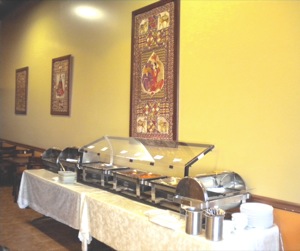dining out
Epicurious Eating: Village Indian Cuisine
Curries, kormas and cows
Published Thursday, 07-Jan-2010 in issue 1150
Northern Indian cuisine is both common and rare to American soil. In scads of restaurants that serve it, the heavy sauces and feisty heat levels inherent to the dishes are disappointingly muted, as to not overwhelm timid palates. But every now and then you find a kitchen that could give a damn, even if it means veering off the beaten track to a strip plaza in Clairemont Mesa.
Village Indian Cuisine duly revolts with a bargain lunch buffet (11 a.m. to 3 p.m.) featuring nearly a dozen meat and vegetarian entrees laced with delightfully loud curries and creamy gravies. It’s priced at $8.95. Though as a word of warning, the dishes are loaded with sodium, a deliberate ploy in northern Indian cooking to amplify the exotic flavors of things like chicken tikka masala, biryani rice and vegetable korma. The high doses of salt merely augment the food rather than dominate it. Just be sure to keep a full bottle of water handy once you get home.
In a break of tradition, the relatively new owners have incorporated beef into their buffet and regular menu. The sacred cow showed up in a buffet item called Keema Muttar – a delicious hash of ground beef with peas and spices, which to the eyes appeared like Taco Bell meat. To the mouth, it was sweet, salty and utterly novel, marking the first time I ever encountered beef in any Indian restaurant.
“Back home we normally use goat or lamb in this dish,” explained one of the family members as he shrugged off the sacrilegious notion. “Here in America, it’s no big deal.”
The restaurant, however, adheres to using proteins lawfully approved for Muslims, known as halal meats. In the modern interpretation, this generally indicates the meats are of are high quality and that the blood is allowed to run out of the animal before slaughtering. Do they taste any different? Not really, but from the Islamic perspective, the meat is considered pure and wholesome.
Everything we tried from the buffet packed steady levels of heat, with the vegetable korma being the spiciest.
“If the korma was this good in other places, I’d get if more often,” my companion exclaimed. “The gravy is more savory and not nearly as coconut-influenced like other standard versions.”
Another outstanding vegetarian dish on that day’s buffet was mushroom masala sporting a sauce that was browner than the cream-kissed red sauce cloaking tender cubes of breast meat in the chicken tikka masala. The mushroom dish, we guessed, packed stouter spices in comparison. Both were addictive and offered a notch more heat than what you’ll find in “safer” Indian restaurants around town.
Your cool down comes in the form of classic kachumber salad, comprised of cucumbers, tomatoes and coriander, and dressed here in a mild splash of rice vinegar. Scoop it up with a wedge of hot, puffy naan bread and you’re ready for round two.
Other dishes on the day’s buffet included chicken curry, tandoori chicken, biryani rice with saffron and excellent daal composed of lentils cooked in cardamom and yellow curry. We were spared the usual “fillers” of heavily battered fried stuff – samosas and pakora that tend to spill over from Indian spreads this reasonably priced. The offerings change daily, so perhaps we merely lucked out.
Village is small and clean with an ornate tapestry looming over about a dozen tables. It’s the kind of place where you eat and run — nothing fancy, but if it were an Indian restaurant with plush, royal surrounds, the food would fit the scheme like a designer silk saree.
|
| |||||||||||||||||||||||||||
Copyright © 2003-2025 Uptown Publications


